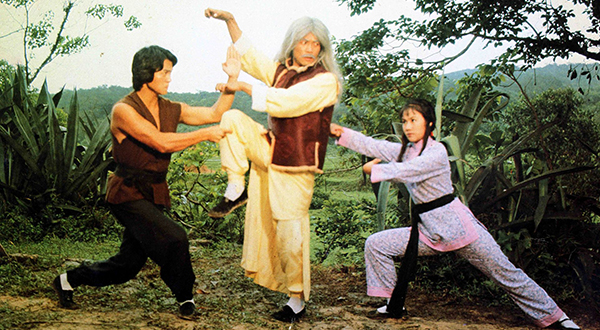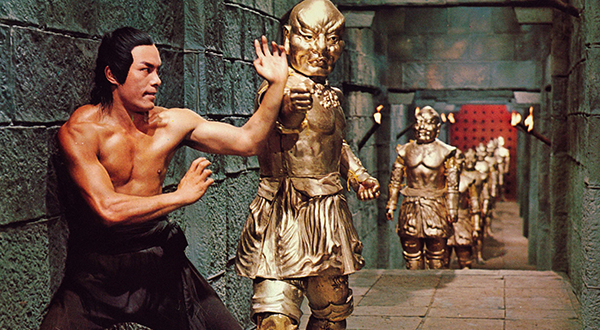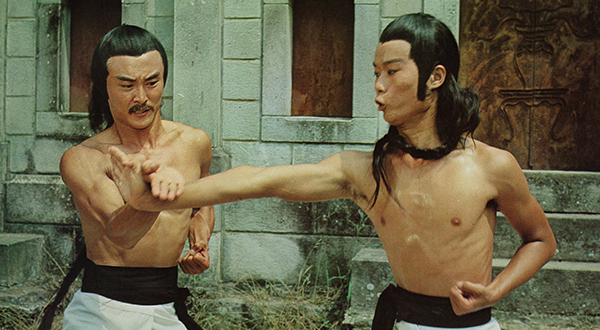I can’t believe I’ve gone this long without discussing at length the Old School Kung Fu Fest, one of the side projects by the founders of Subway Cinema and the New York Asian Film Festival. Granted, this blog isn’t as regularly updated as it once was (which will hopefully change very soon), plus when it comes to Asian movie coverage, I tend to focus on latest releases as opposed to classics. But this year’s installment is a mix of old and new, of sorts: the headliners are four Joseph Kuo classics, in 4K.
Bruce Lee, Sammo Hung, Gordon Liu, and Jackie Chan are the names that are mostly commonly cited as being the driving forces behind the popularity of kung fu flicks, for obvious reasons, but those talents alone couldn’t feed everyone’s appetite. What the Hong Kong movie industry needed were gifted filmmakers who could literally churn out movie after movie, one after another, with quick turnaround and very limited resources, yet make each film wholly unique and entertaining. And that’s exactly what Joseph Kuo did.
Hence the focus of this year’s retrospective, including films that have been given 2K restoration. This is both a blessing and a curse, to be honest…
________________________________________________________________________________
36 Deadly Styles

Perhaps discussing the plot is pointless because, let’s be honest, kung fu flicks of their era were not known for complex or nuanced narratives. All that really matters is the kung fu fighting, but as a vehicle to indoctrinate audiences to the ways of Joseph Kuo, 36 Deadly Styles is again a mixed bag. The 2K treatment turns this movie, and the other three, into something that the audience will be completely foreign with. Poor film quality is the aesthetic that is most synonymous with this type of cinema, so the pristine visual clarity is practically jarring. But yes, the fight scenes look great, especially those that take place outdoors; the vividly detailed forests and mountain top really adds a sense of, dare I say, realism to the proceedings? But the finer details come at a price, and what doesn’t look so hot is the hair and make-up. Also not improved, but it can’t be helped, is the audio, but sound recording was pretty crude for all HK film productions until relatively recently.
But I may as well talk about the plot anyway, which is pretty standard fare for anyone familiar with the genre: a young man and his uncle are in hot pursuit of members of a rival gang, or something like that. They manage to make it to a monastery where one of the senior monks is not only short tempered (to be fair, many of the disciples there are kinda dummies) but also has a violent side, which comes in handy cuz the aforementioned duo gets ambushed. It is eventually revealed that said monk is also a target of said clan but in hiding and decides to train the said young man, to help gain revenge for the murder of said uncle during said ambush. It’s your typical tale of revenge, but the proceedings is also pretty wacky, which alas affects the action; there’s just something about a film centered on an individual that’s supposed to be seeking vengeance being a total goofball. Hence why 36 Deadly Styles is not exactly held in the highest of regards among many kung aficionados.
You also have a subplot involving a soy milk maiden, who ends up being the biggest distraction for our vengeance seeker, along with the film’s even dopier central bad guy who is too much of a chickenshit heel to be taken seriously; he ends up being joined by Bolo Yeung, but even then he’s wearing the ridiculous looking wing, imaginable (actually all the bad guys have terrible hair), which I’m sure looked just as silly in previous non-2K editions. In many ways, the film has more character than other kung fu flicks, but familiar tropes can be found as well, like the obligatory training scene and a showdown with the big boss with long white hair. Yet in the end, of the four flicks, 36 Deadly Styles is perhaps the least noteworthy or interesting, but it may still be a more worthwhile trip to the theater than… to be honestly, I have no idea what else is playing, I kinda of no longer pay attention to that kind of stuff, and this was before COVID came to town (get your ticket here).
The 18 Bronzemen

Okay, now we’re talking. First off, as opposed to the previously discussed movie, the narrative is basically as basic as can be, and that’s a good thing: again, a young man in peril is dropped off at a monastery, but it’s literally a child this time, who grows up learning the Shaolin ropes. He’s earnest and ambitious, but most importantly, not a goofball, though not as dour as his pal, portrayed by the film’s stand out actor IMHO: Carter Huang, best known as Thunder in Big Trouble In Little China. Anyhow, to complete the training and become a full-fledged Shaolin monk, one needs to pass a series of tests of strength, aka face off against the titular 18 Bronzemen. These are literally dudes covered head to toe in bronze body paint, though some are sporting rather large and goofy looking bronzemen suits. Most of the aforementioned tests involve combat with the Bronzemen, but some require the participants to basically eat shit and survive.
Which our heroic duo manages to do. Both are encouraged to roam the countryside and spread the word of Buddha, basically just do good stuff for folks who might need help. When the young man that’s now a fully-fledged monk visits his hometown, as it was suggested on graduation day, the reason why he was dropped off in the monastery in the first place is finally disclosed: he’s the last living descendant of a general in the Ming Dynasty, and the current Qing Dynasty wants to wipe the bloodline away. Along the way he encounters another classic kung fu flick trop, the female warrior that everyone mistakes as a guy, and who ends up becoming the love interest. The two cross paths with Thunder, and the now heroic trio goes after the Qing Dynasty scum that’s behind everyone’s troubles. The 18 Bronzemen doesn’t reinvent the wheel, but that’s fine, totally fine, largely due to the stellar acting by the phenomenal cast; one can’t help but root for the protagonist, every step of the way, from the Bronzemen-laden gauntlet to the final showdown with… the big boss doesn’t have white hair this time, but there’s like four of them, so it’s a showdown with doppelgangers, which is pretty neat.
Return of The 18 Bronzemen
Clearly the studio knew that they had struck gold, because the sequel was seemingly green-lit before the predecessor had even hit the box office. In fact it came out first for some reason, according to Subway Cinema’s write-up. Said description also points out that the sequel also tells a story from the other side’s point of view, kinda/sorta, via a dishonest prince that’s part of the Qing Dynasty, portrayed by a returning Carter Huang. Actually, all of the principal actors from the first film are back, though Thunder is the star of the show, hence why the film manages to succeed despite a very less than traditional story that’s told. And that’s because… even if the original The Bronzemen had not hit the big screen yet, perhaps there were test audiences that reacted VERY positively to the Bronzemen themselves, hence why they are clearly the focus of the sequel, with the gauntlet not only longer than before but also way more over the top.
The Bronzemen in bronze suits are back, but whereas the previous version was more like Tony Stark’s Mark 1 Iron Man suit, these are more like the Mark 2. Honestly, there’s not much to talk about here plot-wise, it’s mostly just someone who is supposed to be a bad guy, who deceived his way to the throne, and mostly wants to know Shaolin kung fu to become the ultimate killing machine. BUt the thing is, it’s hard not to root for him, partly due to Huang’s on screen charms, but also due to the fact that the crooked prince legit puts in the effort to pass the tests. Also, the ending kinda makes no sense, as if it was setting up another kung fu flick… that came out that same year, but from a different director, and a different studio, and honestly has no ties with Return of The 18 Bronzemen. Was Joseph Kuo pals with Jimmy Wang? It doesn’t matter, just know that 18 Bronzemen & Return of the 18 18 Bronzemen is a great one-two combo; both are playing back to back, and it’s a double feature that reminds one of the glory days of the Music Palace (get tickets here and here)
7 Grandmasters

If you have to see only one Joseph Kuo film, let it be 7 Grandmasters. It contains the best qualities of 36 Deadly Styles & The 18 Bronzemen, but cranked up to 11. Again, the story seems rather by the numbers, but as before, it’s all about the execution: a grandmaster of the Bak Mei (yes, the name sounds similar to Pai Mei in Kill Bill; Pai Mei is the fictionalized version of Bak Mei, a living person who was one of the survivors of the destruction of the Shaolin monastery by the Qing) fist, who runs a school, is about to put a sign given by the emperor to let everyone that he’s the absolute best. But then a hater shows up with a message: “Oh yeah? Prove it.” And thus the grandmaster decides to do just that, by traveling across the land and beating every other grandmaster he encounters (yes, there are seven in total).
Along for the journey are his star students, as well as a tagalong who non-stop begs to be taken on as the next student, and the grandmaster basically says “thanks but no thanks” (his students are far less friendly about it). As one might expect, he’s eventually but reluctantly taken on, and wouldn’t you know, the wannabe ends up being amazing after-all, to the point of becoming essentially the star pupil. Hence why the grandmaster teaches him the 9 Strikes of Bak Mei. Technically there are 12 Strikes of Bak Mei, but the final few pages from the guidebook were stolen. Now, why did the former scrub turned number one student want to learn from the best in the first place? To attain the necessary skills to enact revenge over the murder of his father, which as it turns out… you guess it… is his teacher, the grandmaster. Thankfully a mysterious stranger with long white hair is willing to pass along some pro-tips, in the form of… you guess it… the 3 missing strikes.
As noted, 7 Grandmasters is like a perfect combo of the first two films discussed. The best part of 36 Deadly Styles was the gorgeous outdoor fight scenes, and it’s even more so here; all that traversing the countryside equates to encounters across beautiful backdrops, but 7 Grandmasters also happens to have the absolute best fight scenes, with intense fight choreography and equally dynamic cinematography. And the best part of The 18 Bronzemen was the characterizations, and it’s even stronger here. Everyone plays their roles brilliantly, and even though the plot twists and turns come a mile away, one can’t help but be invested; it’s like seeing a play that you’ve seen performed by others countless times, but the strong performance will still take you on that emotional rollercoaster nonetheless. Not sure what else to say, other than, for a non Bruce Lee/Sammo Hung/Gordon Liu/Jackie Chan kung fu flick, it’s one of the absolute best in the bunch; it’s in many ways the perfect B-level kung fu flick, which is absolutely not a knock. I saw a screener of this, one that was generously provided by Subway Cinema, and I knew almost immediately that I had to see it on the big screen, at the Museum of the Moving Image. Of all the movies, the 2K treatment treats 7 Grandmasters the best. Hell, the make-up doesn’t even look that bad either (get your ticket here).
Two additional notes. First, both The 18 Bronzemen & Return of The 18 Bronzemen came out in 1976, two years before The 36th Chamber of Shaolin, which is how most folks know about Shaolin kung fu, so Joseph Kuo was ahead of the curve on that one. Second, I have no idea how or when or why Bak Mei became Pai Mei, and in the original translation for 7 Grandmasters, the real life Shoalin master was referred to by the fictionalized name. This restored version fixes that.



